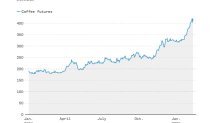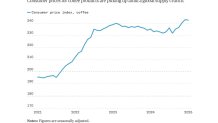Coffee Prices Spike as Arabica Beans Cost More Than $4 per Pound
The benchmark that sets the global price of arabica coffee has more than doubled over the past year, with 25% of that surge coming since the start of 2025. For the first time, one pound of arabica costs more than $4 on commodity markets.
Expect Retail Coffee Prices to Keep Grinding Higher
“Expect retail coffee prices to keep grinding higher,” Bank of America analysts recently warned, even with “consumers showing signs of price fatigue.”
Climate Change-Fueled Weather Patterns Disrupt Agricultural Production
The price run-up is largely driven by climate-change-fueled weather patterns that have disrupted agricultural production around the world. Chocolate prices are up sharply this year for similar reasons, with higher temperatures and rainfall levels spoiling cacao yields in West Africa. In key coffee-growing regions across South and Central America, Southeast Asia, and East Africa, average temperatures are rising, and precipitation patterns are changing, lengthening and intensifying droughts in some places while boosting extreme flood events in others.
Brazil’s Most Severe Drought in 70 Years and Vietnam’s Record Flooding
Brazil has been contending with its most severe drought in 70 years, causing water shortages and crop failures. In Vietnam, months-long drought was followed by severe flooding last year during Typhoon Yagi, which brought extreme rainfall exacerbated by climate change. The two countries are the world’s top coffee producers, accounting for a combined 56% of global supplies.
Arabica Bean Vulnerability to Climate Change
Climate impacts can increase the prevalence of diseases in coffee crops, reducing overall yields for farmers. Studies have shown that the arabica bean, which makes up roughly 60% of all coffee produced globally, is particularly vulnerable to climate change. And while U.S. coffee producers in Hawaii, Puerto Rico, California, and elsewhere sell homegrown beans, their output is nowhere near enough to satisfy domestic demand, a reality shared by farmers of imported specialty crops from wasabi to goji berries.
“As the long-term climate changes, these weather conditions are far more likely to hit extremes and cause losses in coffee yields as well as volatility to coffee production,” said Jeffrey Sachs, a sustainable economist at Columbia University.

Retail Coffee Prices to Keep Rising
Retail coffee prices are expected to rise in a “pronounced” way during the first quarter of this year, the Bank of America analysts wrote in a note to clients. They expect major food companies — such as J.M. Smucker, which sells coffee under multiple brands including Folgers, and Keurig Dr Pepper, which sells Lavazza coffee — to pass at least some of the cost increases on to consumers.
Neither company responded to requests for comment.
Coffee Prices Not Yet Fully Passed On to Consumers
So far, higher coffee prices on commodity markets haven’t fully percolated into consumers’ mugs. Federal data released Wednesday showed the prices people paid for coffee, in all its forms, were roughly flat from December to January, though they were up 3.1% last month from 12 months earlier — just a little bit hotter than inflation overall. But instant coffee prices have been heating up, soaring 7.1% last month from a year earlier, and by 4.4% just from December to January.



